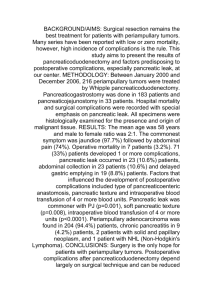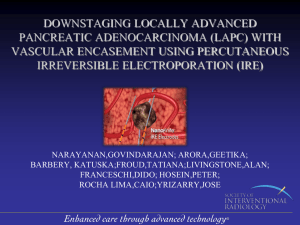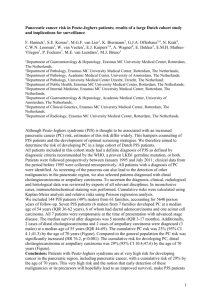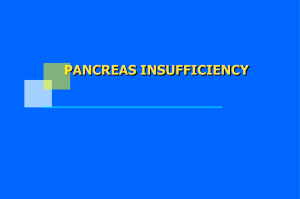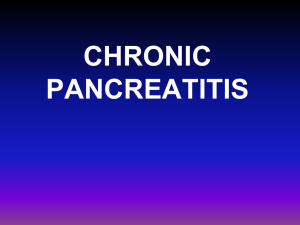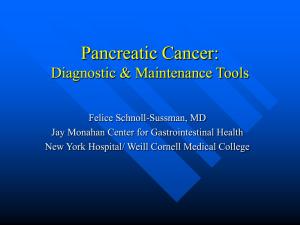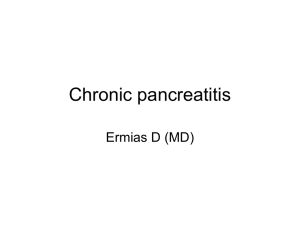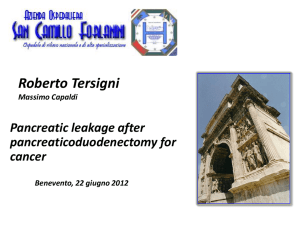File
advertisement
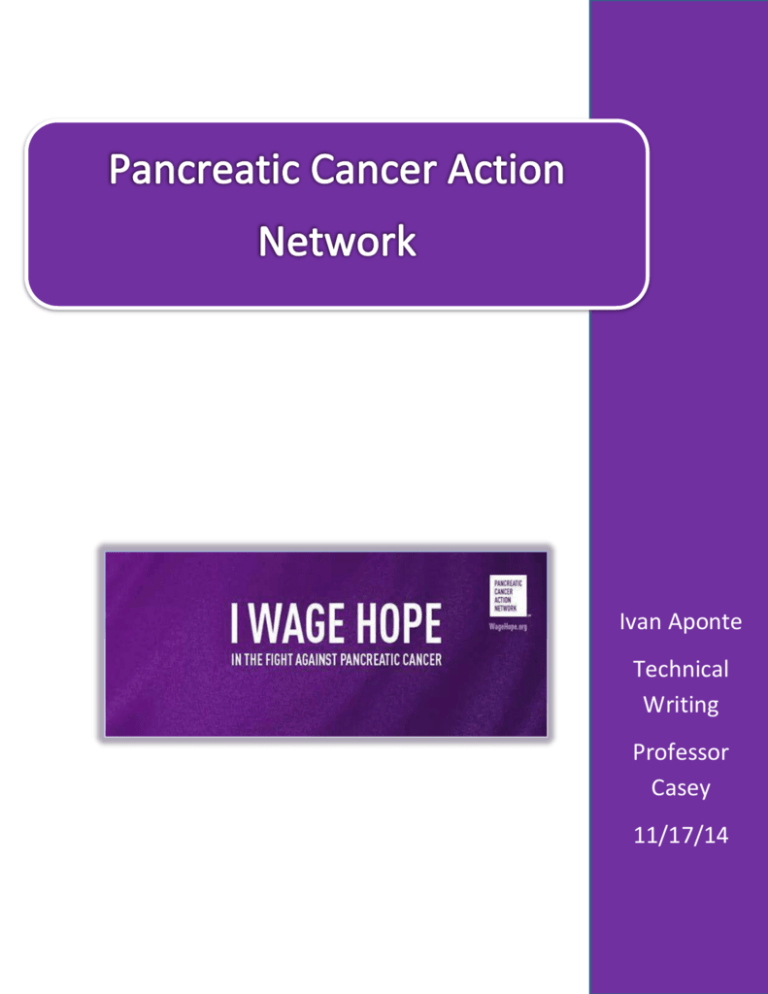
Ivan Aponte Technical Writing Professor Casey 11/17/14 1|Page Table of Contents 3 ………………………………..Introduction 4 ……………………….……….Problems 7 ………..………………………Solutions 10 ……..……………………….Benefits 12 …..………………………….Concluding Thoughts 13 …..………………………….Reference Page 2|Page The Pancreatic Cancer Action Network is a non-profit organization that was created on February, 1999. This organization, comprised of over 1 million members, serves to fund research for pancreatic cancer, inform patients and their family members about the disease through their patient and liaison services, and increase awareness in the general public. The story of the Pancreatic Cancer Action Network begins with Pamela Acosta Marquardt, the founder of this organization. In June of 1996, Rose Schneider, Ms. Marquardt’s mother is diagnosed with pancreatic cancer and only has 3-6 months to live. Knowing this information, Ms. Marquardt gathers as much information as about the disease. The only source of useful information she was able to get a hold of was from “…an online discussion board dedicated to pancreatic cancer hosted by Ralph Hruban, MD, a pathologist at Johns Hopkins University Medical Center” (Pancan 2014). This discussion board was Pamela’s lifeline as she dealt with her mother’s diagnosis. After her mother’s passing, Ms. Marquardt continued to access the discussion board to console herself and to help others who were dealing with the disease. She found that members of the discussion board had become frustrated with the lack of resources to their community. This frustration led to action. Ms. Marquardt got the ball rolling by staging a black tie celebrity event that raised money for an early detection lab for pancreatic cancer. The fundraising event was a success. This event, along with other events, led to the formation of the Pancreatic Cancer Action Network in February of 1999. From the start, hundreds of volunteers were ready to build awareness for the long misunderstood and neglected disease (Pancan). 3|Page According to The Center of Disease Control, cancer ranks second in the leading causes of death in the United States for 2014 next to heart disease (CDC 2014). With this statistic in mind, “Pancreatic cancer is currently the fourth leading cause of cancer death in the United States, and is anticipated to become the second by 2020” (Pancan 2014). The Silent Disease Pancreatic cancer is given the name “the silent disease” for a reason. This specific cancer will not show any symptoms or signs of existence until it develops more in the late stages. Even then, the symptoms that are presented are vague and are similar to other diseases that could be presented in the gastrointestinal area. By the time diagnosis for pancreatic cancer is made, the cancer will more than likely be in an advanced stage and treatment options often will have no benefit. 4|Page Surgery Is Often Obstructed Another factor that makes pancreatic cancer so dangerous is where it is located in the body. The pancreas is located deep in the abdomen, hidden beneath many different layers of tissue. Removing a pancreatic tumor in this condition is often difficult at times. Only 15-20% of patients diagnosed with pancreatic cancer are diagnosed early enough that their tumor can be removed surgically (UCSF Health). This low rate for surgical removal is due to the fact that the malignancy of the pancreatic cancer would have more than likely already spread to other regions of the body, making it surgical removal impossible. Even if surgery can be done for the removal of the tumor, the cancer often returns. Low Survival Rate The current survival rate for pancreatic cancer is very slim. Because of the contributing factors that make treatment for pancreatic cancer difficult, the one-year relative survival rate is 20%, and the five-year rate is 6% (American Cancer Society). 5|Page Many American lives are affected annually due to pancreatic cancer. The American Cancer Society estimates that as many as 46,420 people will be diagnosed with pancreatic cancer and that 39,590 people will die from it (American Cancer Society 2014). The numbers of people afflicted with pancreatic cancer and deaths will only continue to increase exponentially as it has in the past decade or so. Underlying Causes Pancreatic cancer, like all cancers, can be caused by a number of factors. For pancreatic cancer, WebMD links genetics, diabetes, smoking, obesity, diets with high fat and meat content, and deficiencies in lycopene and selenium as contributing factors that will increase the risk of developing this disease (WebMD). Besides genetics, these factors that are listed can be prevented by changes to one’s lifestyle. 6|Page Solutions Early Detection One of the main focuses of the research funds amounted by the Pancreatic Cancer Action Network goes towards early detection. Some scientists are combating pancreatic cancer by improving current early detection methods and creating new ones. Because of the deep location of pancreas, doctors are not able to check for tumors during a physical exam. Therefore, early detection is crucial to fighting this “silent” disease. Genetic Testing One method of detection is genetic testing. Some people may be more at risk of pancreatic cancer if the person has a family history of that disease. “Inherited DNA changes are thought to cause as many as 10% of pancreatic cancers” (American Cancer Society). Though this test does not determine whether you will get pancreatic cancer, it will determine whether you are more at risk. Endoscopic Ultrasound Another method of detection for pancreatic cancer is endoscopic ultrasound. This is a newer method of detection which combines endoscopy and ultrasound in order to obtain images and information about the digestive tract and the surrounding tissues and organs (Medicine Net). Essentially, a healthcare professional would insert an endoscopic tube with an ultrasound transmitter on the tip of it like he or she would for a regular endoscopy procedure. Then, when the transmitter is near the pancreas, the ultrasound transmitter will emit sound waves and produce a high quality image of the pancreas. Using this image, a doctor will be able to determine if there is an abnormal growth on the pancreas or not. 7|Page Treatment Another focus of the research funds that are raised by the Pancreatic Action Network are actual methods of treating pancreatic. There are a number of different forms of treatment that the research funds go towards. Funding may go towards improving current methods of treatment to make them more effective or creating new methods to tackle the cancer in a different angle of approach. Immunotherapy As far as treatment goes, a lot of research is going into immunotherapy. In a nutshell, immunotherapy is using the body’s natural immune system as a way to combat pancreatic cancer. “The immune system’s natural capacity to detect and destroy abnormal cells may prevent the development of many cancers” (National Cancer Institute 2014). These therapies can do one of two things: they can stimulate key components of the immune system or counteract signals produced by cancer that suppress the immune system. Immunotherapy is undergoing more research so that scientists can broaden its use. Targeted Therapy Another form of treatment for pancreatic cancer is targeted therapy. Targeted cancer therapies are drugs designed to interfere with specific molecules necessary for tumor growth and progression (My Cancer Genome 2014). Targeted therapy is not to be mistaken with chemotherapy, which targets all cells that divide in the body. Chemotherapy 8|Page A widely known form of treatment for pancreatic cancer is chemotherapy. Chemotherapy is a “drug treatment that uses powerful chemicals to kill fast-growing cells in your body” (Mayo Clinic 2014). Since cancer essentially consists of fast-growing abnormal cells, chemotherapy is often an effective medicine for combating a wide range of cancers. However, there are some negative connotations that come with this method of treatment. Chemotherapy carries the risk of side effects. Although some of these side effects are mild and treatable, there are others that can cause serious complications in the treatment process. Healthy Lifestyle Though funding does not go towards maintaining a healthy lifestyle, the Pancreatic Cancer Action Network advises people to pursue this Although this is not exactly a cure for pancreatic cancer, maintain a healthy lifestyle can help prevent it and even aid other treatments being implemented for those who already have pancreatic cancer. Consuming a healthy diet will help prevent development of obesity and diabetes: two factors that linked to the cause of pancreatic cancer. In addition to a healthy diet, maintaining a regular workout routine will further aid the prevention of obesity and diabetes. Smoking is one of the major causes linked to pancreatic cancer. “The number one way to prevent pancreatic cancer is to stop smoking” (MD Anderson Cancer Center). One can simply lower the risk of pancreatic cancer by putting the cigarette down or not even trying it to begin with. 9|Page Research Funds towards Pancreatic Cancer The Pancreatic Cancer Action Network has risen over $23 million in research funds. The grand amount has been distributed into 110 grants that are awarded to well qualified scientists and institutions who conduct research on pancreatic cancer. With these grants, the scientists and institutions can focus their energy and resources on improving diagnostic tools, innovating more effective methods of early detections, improve current treatment options, and create new treatment options. Because of the efforts of the Pancreatic Cancer Action Network, we understand the biological make up of pancreatic cancer far better than we did two decades ago. The organization recently evaluated their research grants program looking at the span of 20032011. 66 grants were awarded at a total amount of $9.15 million. With the data allocated, the Pancreatic Cancer Action Network was able to conclude that the awarded scientists were able to “…leverage the $9.15 million investment into $91 million in subsequent pancreatic cancer research funding” (PanCan). Patient and Liaison Services (PALS) 10 | P a g e The Pancreatic Cancer Action Network does not only raise funds for pancreatic cancer research, but they also offer one-to-one support. The Patient and Liaison Services (PALS) is a “comprehensive and free information service for pancreatic cancer patients, their families and healthcare professionals” (PanCan). The information they offer include: treatment options, clinical trials, disease information, specialist physicians, diet and nutrition, side effect management, support resources, and more. So far, 90,000 patients and families have been served by PALS. This service goes to show the sentiment and care the organization has for the people troubled by pancreatic cancer. Purple Stride Every year, tens of thousands of people across the nation will participate in 1 of 50 PurpleStride events. They can range from brief walks to long distance timed runs. PurpleStride has one common goal – to end pancreatic cancer. These events raise awareness about the mission of the Pancreatic Cancer Action Network and give the community an opportunity to “make strides towards a better future” (PanCan). PurpleStride contributes millions of dollars towards pancreatic cancer research, support patients, and create hope. “For participants, it is a journey toward hope that is filled with inspiration” (Pancan). PurpleStride serves as a supportive environment with likeminded individuals who want to see the end of pancreatic cancer. With these events, communities can band together and increase awareness in the fight for pancreatic cancer. 11 | P a g e As many can see, the Pancreatic Cancer Action Network is an organization whose cause is worthy of support. This non-profit organization has already made many contributions to pancreatic cancer research in its 18 years of existence. From development of new age diagnostic tools and detection methods, to improving current pancreatic treatment methods and creating new ones, the Pancreatic Cancer Action Network puts forth its efforts to support this research. Continual funding for the Pancreatic Cancer Action Network will be beneficial to society, as they hope to make the pressing issue of this disease a thing of the past. With their one-on-one support (PALS), they offer emotional support and important information to the uninformed about pancreatic cancer. To make contributions to the Pancreatic Cancer Action Network, one could a donation through the organization’s website. Not only can one contribute to the organization financially, you can also volunteer for the organization. Through the website, a person is able to find a local volunteer effort. The website also gives you information on PurpleStride events happening throughout the year. If you wish to contact the Pancreatic Cancer Action Network, you may call them on the toll free number 877-272-6226 or email them at info@pancan.org. 12 | P a g e Reference Page Abramson, R.G. (2014). Overview of Targeted Therapies for Cancer. My Cancer Genome. Retrieved November 21, 2014 from http://www.mycancergenome.org/content/other/molecular-medicine/overview-of-targetedtherapies-for-cancer/ (Updated November 18). American Cancer Society. (2014). What are the key statistics to pancreatic cancer? Retrieved from http://www.cancer.org/cancer/pancreaticcancer/detailedguide/pancreatic-cancerkey-statistics Chemotherapy. (2014, May 5). In Mayo Clinic online. Retrieved from http://www.mayoclinic.org/tests-procedures/chemotherapy/basics/definition/prc-20023578 Hoyart, D. L. & Xu, J. (2012, October 10) National Vital Statistics Report. Retrieved November 10, 2014 from http://www.cdc.gov/nchs/data/nvsr/nvsr61/nvsr61_06.pdf (2014, October 17). Immunotherapy: Using the immune system to treat cancer. National Cancer Institute. Retrieved November 10, 2014 from http://www.cancer.gov/researchandfunding/progress/immunotherapy-using-immune-system-totreat-cancer MD Anderson Cancer Center. (2014).Pancreatic cancer prevention and screening. Retrieved from http://www.mdanderson.org/patient-and-cancer-information/cancerinformation/cancer-types/pancreatic-cancer/prevention/index.html Medicine Net. (2014). Endoscopic ultrasound. Retrieved from http://www.medicinenet.com/endoscopic_ultrasound/article.htm (Medicine Net) (2011). Results and accomplishments. Pancreatic Cancer Action Network. Retrieved November 10, 2014 from http://www.pancan.org/ UCSF Medical Center. (2014). Pancreatic cancer treatment. Retrieved from http://www.ucsfhealth.org/conditions/pancreatic_cancer/treatment.html Web MD. (2014). Pancreatic cancer causes and risk factors. Retrieved from http://www.webmd.com/cancer/pancreatic-cancer/causes-pancreatic-cancer 13 | P a g e

